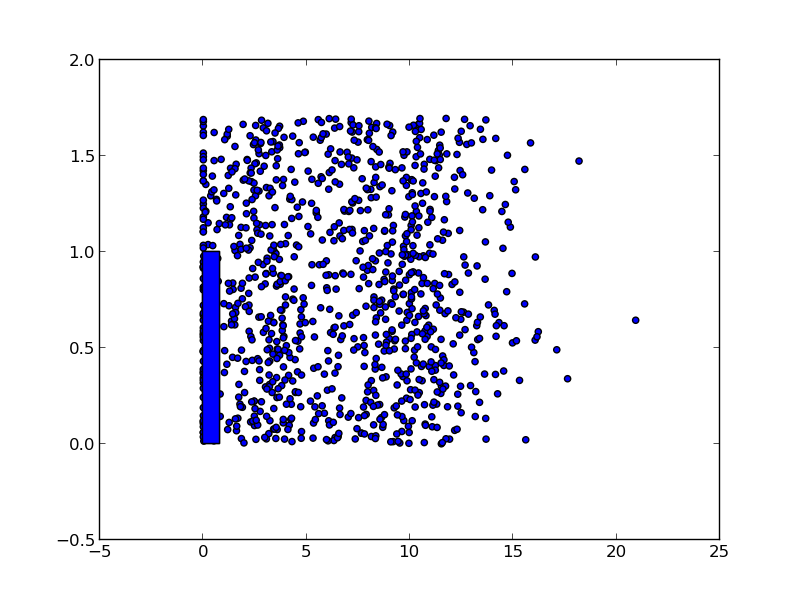機器學習實戰2--K近鄰
本部落格基於機器學習實戰這本書,主要是對機器學習的演算法原理及python實現進行詳細解釋,若是有些沒有闡述清楚的,看到的請指出。
第二章的K近鄰演算法是一個簡單的機器學習演算法。
K近鄰演算法:
原理:收集一個樣本資料集合,並且樣本集中每個資料都存在標籤。輸入沒有標籤的新資料後,將新資料的每個特徵與樣本集中資料對應的特徵進行比較,然後演算法提取樣本集中特徵最相似資料(最近鄰)的分類標籤。選擇樣本資料集中前K個最相似的資料,這就是K近鄰演算法中K的出處,通常k是不大於20的整數。選擇k個最相似資料中出現次數最多的分類,作為新資料的分類。
演算法實現:新建一個kNN.py檔案
1. 匯入資料
#-*- coding: utf-8 -*- #表示使用這個編碼
from numpy import * #匯入科學計算包NumPy,沒安裝趕緊百度安裝
import operator #運算子模組,k近鄰演算法執行排序操作時將使用這個模組提供的函式
import pdb #在Python互動環境中啟用除錯
from os import listdir # os 模組包含了許多對目錄操作的函式 listdir 函式返回給定目錄下的所有檔案
def createDataSet():#定義一個函式,建立資料集和標籤
group = array([[1.0,1.1],[1.0,1.0 儲存後import kNN
group,labels = kNN.createDataSet(),然後就可以得到group,labels
- 具體的kNN演算法:
思想:計算已知類別資料集中的點和當前點之間的距離;
按照距離遞增次序排序;
選取與當前點距離最小的k個點;
確定前k個點所在類別的出現頻率;
返回前k個點出現頻率最高的類別作為當前點的預測分類。
def classify0 這樣就可以使用該程式進行資料預測了。
kNN.classify0([0,0],group,labels,3)輸出結果為B。
- 測試kNN演算法
這個測試是作者提供的文字檔案,先解析文字,畫二維擴散圖,kNN不用進行訓練,直接呼叫文字資料計算k近鄰就可以。
將文字記錄轉換為NumPy的解析程式
def file2matrix(filename):#將文字記錄轉換成numpy的解析程式
fr = open(filename) #這是python開啟檔案的方式
arrayOLines = fr.readlines()#自動將檔案內容分析成一個行的列表
numberOfLines = len(arrayOLines)#得到檔案的行數
returnMat = zeros((numberOfLines,3))
classLabelVector = []
enumLabelVector = []
index = 0
for line in arrayOLines:
line = line.strip()#截掉所有的回車符
listFromLine = line.split('\t')#使用tab字元\t將上一步得到的整行資料分割成元素列表
returnMat[index,:] = listFromLine[0:3]#選取前三個元素儲存到特徵矩陣中
classLabelVector.append(listFromLine[-1])#用-1表示最後一列元素,把標籤放入這個向量中
if cmp(listFromLine[-1],'didntLike')==0:
enumLabelVector.append(1)
elif cmp(listFromLine[-1],'smallDoses')==0:
enumLabelVector.append(2)
elif cmp(listFromLine[-1],'largeDoses')==0:
enumLabelVector.append(3)
index += 1
return returnMat,enumLabelVector #返回資料矩陣和標籤向量可以使用reload(kNN)
datingDataMat,datingLabels = kNN.file2matrix(‘datingTestSet.txt’)得到資料矩陣和標籤向量。
- 使用Matplotlib製作原始資料的散點圖
fig = plt.figure()
ax = fig.add_subplot(131)
ax.scatter(datingDataMat[:,1],datingDataMat[:,2])
ax = fig.add_subplot(132)
ax.scatter(datingDataMat[:,1],datingDataMat[:,2],15.0*array(vector),15.0*array(vector))
ax = fig.add_subplot(133)
ax.scatter(datingDataMat[:,0],datingDataMat[:,1],15.0*array(vector),15.0*array(vector))
plt.show()- 在計算KNN距離時,若某一列的數值遠大於其他列, 那這一列對計算距離時的影響最大。將資料歸一化,每一列的資料取值範圍處理為0-1之間,這樣每一列的資料對結果影響都一樣。
歸一化特徵值:
def autoNorm(dataSet):
minVals = dataSet.min(0)#獲得最小值,(0)是從列中獲取最小值,而不是當前行,就是每列都取一個最小值
maxVals = dataSet.max(0)#獲得最大值
ranges = maxVals - minVals#獲得取值範圍
normDataSet = zeros(shape(dataSet))#初始化新矩陣
m = dataSet.shape[0]#獲得列的長度
normDataSet = dataSet - tile(minVals,(m,1))#特徵值是1000×3,而最小值和範圍都是1×3,用tile函式將變數內容複製成輸入矩陣一樣大小的矩陣
normDataSet = normDataSet/tile(ranges,(m,1))#/可能是除法,在numpy中,矩陣除法要用linalg.solve(matA,matB).
return normDataSet,ranges,minVals- 將資料集分為測試資料和樣本資料
def datingClassTest():
hoRatio = 0.10
datingDataMat,datingLabels = file2matrix('datingTestSet.txt')#讀取檔案中的資料並歸一化
normMat,ranges,minVals = autoNorm(datingDataMat)
m = normMat.shape[0]#新矩陣列的長度
numTestVecs = int(m*hoRatio)#代表樣本中哪些資料用於測試
errorCount = 0.0#錯誤率
for i in range(numTestVecs):
classifierResult = classify0(normMat[i,:],normMat[numTestVecs:m,:],datingLabels[numTestVecs:m],3)#前m×hoRatio個數據是測試的,後面的是樣本
print "the calssifier came back with: %d,the real answer is:%d" %(classifierResult,datingLabels[i])
if(classifierResult != datingLabels[i]):
errorCount += 1.0
print "the total error rate is: %f" %(errorCount/float(numTestVecs))#最後打印出測試錯誤率- 構建預測函式,輸入資訊得到預測標籤
#輸入某人的資訊,便得出對對方喜歡程度的預測值
def classifyPerson():
resultList = ['not at all', 'in small doses', 'in large doses']
percentTats = float(raw_input("percentage of time spent playing video games?"))#輸入
ffMiles = float(raw_input("frequent flier miles earned per year?"))
iceCream = float(raw_input("liters of ice cream consumed per year?"))
datingDataMat, datingLabels = file2matrix('datingTestSet.txt') #讀入樣本檔案,其實不算是樣本,是一個標準檔案
normMat, ranges, minVals = autoNorm(datingDataMat)#歸一化
inArr = array([ffMiles, percentTats, iceCream])#組成測試向量
# pdb.set_trace()#可debug
classifierResult = classify0((inArr-minVals)/ranges, normMat, datingLabels,3)#進行分類
# return test_vec_g,normMat,datingLabels
print 'You will probably like this person:', resultList[classifierResult - 1]#列印結果在python下輸入kNN.classifyPerson(),輸入某人的資訊,就可以得到該人的標籤。
8.手寫識別系統的示例:
收集資料時,要將手寫的字元影象轉換成向量。
def img2vector(filename):
returnVect = zeros((1,1024))#初始化一個向量
fr = open(filename)#開啟檔案
for i in range(32):
lineStr = fr.readline()#讀入每行向量
for j in range(32):
returnVect[0,32*i+j] = int(lineStr[j])#把每行的向量分別賦值給初始化向量
return returnVect#返回向量將資料處理成分類器可以識別的格式後,將這些資料輸入到分類器,檢測分類器的執行效果。
def handwritingClassTest():
hwLabels = []
trainingFileList = listdir('trainingDigits')# 得到目錄下所有檔案的檔名
m = len(trainingFileList)#得到目錄下檔案個數
trainingMat = zeros((m,1024))
for i in range(m):
fileNameStr = trainingFileList[i]#對檔名進行分解可以得到檔案指的數字
fileStr = fileNameStr.split('.')[0]
classNumStr = int(fileStr.split('_')[0])
hwLabels.append(classNumStr)#把標籤新增進list
trainingMat[i,:] = img2vector('trainingDigits/%s' %fileNameStr)#把所有檔案都放在一個矩陣裡面
testFileList = listdir('testDigits')
errorCount = 0.0
mTest = len(testFileList)
for i in range(mTest):
fileNameStr = testFileList[i]
fileStr = fileNameStr.split('.')[0]
classNumStr = int(fileStr.split('_')[0])
vectorUnderTest = img2vector('testDigits/%s' %fileNameStr)#得到一個向量
classifierResult = classify0(vectorUnderTest,trainingMat,hwLabels,3)#對向量進行k近鄰測試
print "the classifier came back with: %d the real answer is %d" %(classifierResult,classNumStr)
if(classifierResult != classNumStr):errorCount += 1.0
print "\nthe total number of errors is: %d" %errorCount#得到錯誤率
print "\nthe total error rate is: %f" %(errorCount/float(mTest))使用kNN.handwritingClassTest()測試該函式的輸出結果,依次測試每個檔案,輸出結果,計算錯誤率,因為分類演算法不是絕對的,只是一個概率問題,所以對每一組資料都有錯誤率。
至此,第二章基本闡述完畢,k近鄰演算法是分類資料最簡單有效的演算法,使用演算法時,我們必須有接近實際資料的訓練樣本資料。k近鄰演算法必須儲存全部資料集,如果訓練資料集很大的話,必須使用大量的儲存空間。
優點:精度高,對異常值不敏感,無資料輸入假定
缺點:nisan複雜度高,空間複雜度高。
適用資料範圍:數值型和標稱型。

